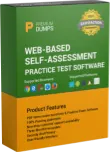
Get IBM C1000-172 Exam Practice Questions - Real and Updated
IBM Cloud Professional Architect v6 Exam Dumps
This Bundle Pack includes Following 3 Formats
Test software
Practice Test
Answers (PDF)

C1000-172 Desktop Practice
Test Software
Total Questions : 64

C1000-172 Questions & Answers
(PDF)
Total Questions : 64

C1000-172 Web Based Self Assessment Practice Test
Following are some C1000-172 Exam Questions for Review
Why does IBM Cloud Analytics Engine decouple compute and storage?
Which high availability strategy will result in a maximum of 4 nines (99.99%) of availability for an IBM Kubernetes Services cluster?
What is the main advantage of using IBM Code Engine over traditional server provisioning?
An IT manager is considering using IBM Key Protect for their organization's data encryption needs. What is the primary objective of IBM Key Protect?
Based on some real-time events, a government entity wants to build a solution for collecting its citizens' data and analyze it for data insights according to some rules and KPIs. The data can be received in different formats, so there is a need to unify all of the data formats through data transformation and filtration rules.
Which IBM Cloud services can help in this case?
Unlock All Features of IBM C1000-172 Dumps Software
Types you want
pass percentage
(Hours: Minutes)
Practice test with
limited questions
Support











